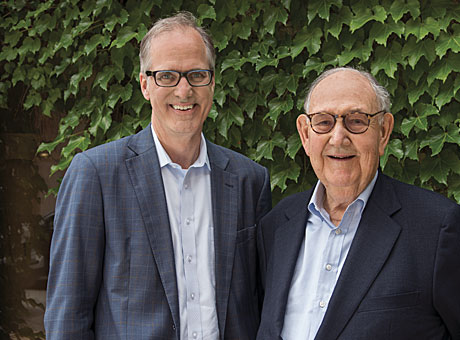
Jeff M. Michalski, MD, left, uses radiation therapy to treat patients like Michael Pulitzer.

Jeff M. Michalski, MD, left, uses radiation therapy to treat patients like Michael Pulitzer.
It’s all about targeting in the battle against cancer. The arsenal to deliver highly targeted radiation therapy for patients with prostate or bladder cancer soon will include new technology evaluated by Washington University radiation oncologists.
“There’s no technology today that allows us to see inside a patient and treat a tumor at the same time. Instead, we use images obtained before radiation treatments to determine a tumor’s size and location,” says Jeff M. Michalski, MD, the Carlos Perez Professor of Radiation Oncology and vice chair of radiation oncology. “The problem is that tumors can shift due to breathing or other movement. Just as neurosurgeons need to see a tumor as they remove it, radiation oncologists need to see the tumor while they radiate.”
Radiation oncologists here are evaluating a first-of-its-kind, combined MRI imaging and intensity-modulated radiation therapy (IMRT) system that provides continuous images of a tumor during treatments. Clinical trials, exclusive to the Alvin J. Siteman Cancer Center, are seeking to measure the value of the technology in cancer therapy.
“We have a long-standing reputation for innovation in imaging and radiation therapy,” says Michalski, an internationally recognized radiation oncologist who has multiple studies under way to enhance treatment outcomes for prostate cancer patients. His latest clinical trials focus on combining radiation and hormone-suppression therapy (androgen deprivation) to try to pinpoint the optimal duration and amount of each while minimizing side effects.
Michael Pulitzer recognizes the strength of Michalski’s research and its impact on patients like him. He characterizes Washington University as having one of the best radiation therapy centers in the world. “The care I received was seamless,” says Pulitzer, who made an unrestricted donation to support Michalski’s research. “As a result, I have what could be called ‘grateful patient’ syndrome. Dr. Michalski cured me, and I want to help him cure others.”
Michalski wants to collaborate with other researchers to find specific genes that impact treatment. “Each patient’s tumor biology may uniquely respond to radiation therapy, and we could tailor the treatment to maximize its benefits. We need to push ourselves beyond what we already know because that results in better, more effective cancer treatments and outcomes,” he says.